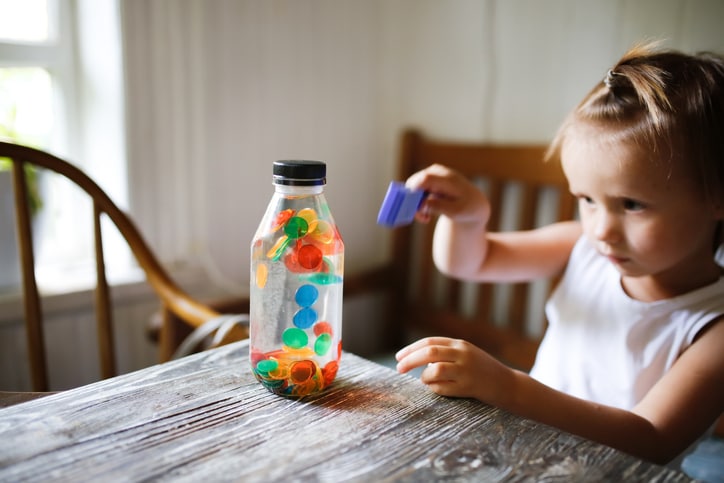In this article
Many parents and caregivers know it’s important to give children space and autonomy to explore life for themselves. Still, sometimes children need guidance and influence to develop healthy patterns. During these times, you may seek helpful strategies that support their long-term success and reflect their needs and interests. Positive reinforcement, a behavioral technique that guides children toward helpful behaviors, may be the answer.
“Positive reinforcement is effective,” says Ashley B. Herndon, a licensed marriage and family therapist with Youth Villages. “Many studies support [it]… and it is widely practiced not only with parenting but also in the classroom, workplace or even with fitness goals.”
Positive reinforcement is often seen as a simpler way to approach behavior, as it’s easier to encourage behaviors rather than discourage them, Herndon adds. Read on to learn more, including positive reinforcement examples and key considerations for incorporating them into your parenting or caregiving strategy.
Key takeaways
- When used correctly, positive reinforcement helps support children as they establish healthy habits and behaviors.
- Positive reinforcement examples can include rewards, praise, offering incentives and experiencing positive consequences.
- To be effective, positive reinforcement must keep the child’s needs, interests and developmental stages in mind.
- Positive reinforcement works best when grounded in warmth and authentic relationships.
What is positive reinforcement?
Positive reinforcement is a behavior technique that means adding something, like a reward or incentive, to increase the likelihood of a certain behavior.
Positive reinforcement has roots in psychology, and involves reinforcers (efforts to increase a behavior) and punishments (efforts to decrease a behavior). “Simply put, positive reinforcement tells us that behaviors that are positively reinforced will repeat more frequently,” Herndon says.
So, how do you actually reinforce those kinds of behaviors? In the context of parenting and caregiving, we see many examples of positive reinforcement, Herndon adds, including praise, reward charts and doing special activities.
There are four main categories of positive reinforcement, Herndon explains:
- Natural reinforcers. These occur without prompting. “For example, a child practicing rollerblading makes it across the driveway without falling.”
- Token reinforcers. Awards for performing a behavior are exchanged for something of value. “For example, a star chart for making the bed. At the end of the week, the child can pick a prize for earning five stars.”
- Social reinforcers. Based on forms of social approval, like praise or recognition. “For example, saying, ‘Great job using a quiet voice,’ offering high fives or hugs, or giving extra privileges.”
- Tangible reinforcers. Physical rewards. For example, a piece of candy is given when the child’s backpack and coat are hung up after school. (Note: Some experts believe tangible reinforcement is least effective for keeping people intrinsically motivated.)
When to use positive reinforcement
Positive reinforcement can be useful anytime you want children to increase the frequency of a certain good behavior. Family customs and culture will shape the specific behaviors you want to increase, but some common behaviors that can be encouraged through positive reinforcement:
- Coming home and starting homework before screentime.
- Asking before getting a snack.
- Pushing through on a difficult task.
- Identifying and sharing feelings instead of throwing a tantrum.
- Waiting patiently.
- Cleaning up after themselves or doing chores.
- Compromising or being flexible.
- Handling a disagreement or disappointment without a tantrum.
- Directly communicating needs.
- Playing nicely with relatives or friends.
At first mention, positive reinforcement may sound like a complicated concept, but it’s actually all around us, like hearing words of affirmation from a friend or getting a paycheck for completing work. Positive reinforcement works because kids — and adults — learn and grow when we are having fun, adds Asha Dore, a speech-language pathologist and writer.
“Sometimes, figuring out a child’s motivation or how to pair it with a necessary activity can be tricky, but it’s worth the effort.”
— Asha Dore, speech-language pathologist and writer.
Still, positive reinforcement requires mindful and intentional use in order to be effective, she adds. Knowing what incentive motivates each child takes observation and customization. “For example, if a kid loves Roblox, their speech and language activities can be about Roblox — or, if it’s possible to work on developmental skills while playing Roblox, even better,” Dore says. “Sometimes, figuring out a child’s motivation or how to pair it with a necessary activity can be tricky, but it’s worth the effort.”
Positive reinforcement examples
Here are some helpful positive reinforcement examples from our experts. You can customize these ideas to meet each child’s individual interests, needs and goals.
Natural reinforcers
- Kids enjoy a clean space because they cleaned their room.
- A child feels more prepared in school because they’ve stuck to their study schedule.
- A child skillfully recites their lines for a play because they have rehearsed consistently.
- Kids feel increased energy and focus because they’ve met household fresh fruit goals.
- A child sees their garden plot grow big and strong after regular care and maintenance.
Token reinforcers
- Distributing stickers kids can trade in for prizes for correctly doing chores.
- Behavior bucks for following rules that can be used for extended curfew or screen time.
- Points on a chart exchanged for their favorite sweet treat.
- Tokens for good behavior that are redeemable for family outings.
- Offering activity tickets for homework completion.
- Points earned toward experiences or prizes, like a trip to the movies.
Social reinforcers
- Displaying your child’s art on the refrigerator.
- Offering a “good job” or high five on their attention to detail during a puzzle.
- Giving specific praise by saying, “I’m so proud of how you __________.”
- Commending how responsible they were during time out of the house.
- Celebrating their accomplishment by telling someone else, in front of them. (Note: This could be embarrassing for shy or older kids)
- Expressing gratitude for their patience during a meeting or appointment.
Tangible reinforcers
- Buying a child a video game after they meet their monthly reading goal.
- Offering kids a popsicle after cleaning their rooms.
- Buying the latest graphic novel in a child’s favorite series as a reward for completing tasks.
- Offering your child a new phone after they respect boundaries with a hand-me-down phone.
- Offering kids more gaming time for sharing with a sibling.
- Getting a pet after kids prove they can be responsible by volunteering at the animal shelter.
Is positive reinforcement the same as bribery?
Let’s address the elephant in the room: To some, positive reinforcement can sound like bribery and feel “counterintuitive” to encouraging kids to do the right thing on their own.
One key difference between positive reinforcement and bribery is when the reward is offered. “In the case of bribery, the reward is given before the behavior or action and is an exchange; ‘I will give you a cookie if you sit quietly while we wait for the oil change,’” Herndon says. In contrast, positive reinforcement offers a reward after completion of a desired behavior.
Put more simply, instead of a bribe that persuades children into a one-time behavior expression, positive reinforcement seeks to establish a pattern or inspire long-term behavior shifts through connection and collaboration.
“Knowing a child’s likes helps make a connection with what would be desirable and enjoyable for them,” says Herndon. “Reinforcing behaviors that help them develop a sense of competence, creativity and mastery helps to deepen intrinsic motivation so that the need for external rewards is lessened.”
“The [positive] reinforcement method should be provided immediately after the desired behavior is observed to make that connection between the behavior and the reinforcer strongest.”
— Ashley B. Herndon, licensed marriage and family therapist
Common positive reinforcement mistakes to avoid
1. Not clearly communicating expectations
For positive reinforcement to work, parents and caregivers must communicate their expectations. Some experts suggest the “Explain, model, and repeat” strategy.
- Explain: Be clear in what you want your child to do. For example, “I’d like you to clean your room making sure all the clothes are put away, the trash is picked up and the games are off the floor.”
- Model: Show them what a clean room looks like (even better if you can clean the room with them the first time).
- Repeat: Inform them of the expectation each time. It could be useful to write it on a dry erase board or some other area for display.
Similarly, Dore notes, it’s important to recognize that the language we use with ourselves and with children reveals our outlook and can influence success. She says generalizations like “always” or “never” — for example, ‘You never organize the dishwasher right,’ or ‘It’s always messy in here’ — can hinder progress.
2. Not responding promptly or consistently
“The [positive] reinforcement method should be provided immediately after the desired behavior is observed to make that connection between the behavior and the reinforcer strongest,” says Herndon.
When reinforcers are offered too late — for example, a child meets their reading goal for May and you forget to offer the reinforcer until July — you can unintentionally undermine your efforts. Similarly, if you offer the reinforcer at an interval that is too frequent — for example, giving a piece of candy every time a child follows an instruction — you can remove the intrinsic (internal) motivation to complete a task and create a sense of expectation for reward.
3. Using one-size-fits-all reinforcers
Every example of positive reinforcement isn’t a fit for every family, child or developmental stage. Herndon says it’s important to be creative within your limitations and value system.
For example, if your family doesn’t value material things, you don’t have to use tangible reinforcers. “A family that values quality time may use rewards like a day spent together or choosing a puzzle to work on together.”
4. Responding to kids while dysregulated
Both Herndon and Dore note that adults are teaching important lessons about emotional regulation as they seek to reinforce desired behaviors.
“Our ability to communicate effectively (and, therefore, effectively discipline or provide positive reinforcement) is impacted if we are upset,” says Dore. “It’s OK to take breaks and to communicate positive self-soothing activities like, ‘I’m upset, so I’m taking a five-minute break,’ or, ‘I want to help you, but I’m feeling ______. I’ll be right back.’”
A final word of advice from an expert
Positive reinforcement isn’t successful overnight. Like any new skill, it requires time, patience and consistency. Herdon notes that a plan of implementation or a positive reinforcement behavior chart can help support consistency. Additionally, you can consult the following resources to learn how to better implement positive reinforcement with the kids in your care:
- “How to Talk so Kids Will Listen & Listen so Kids Will Talk” by Joanna Faber and Julie King.
- “The Explosive Child” by Dr. Ross Greene.
- “The Gift of Failure” by Jessica Lahey.
- “Raising An Emotionally Intelligent Child: The Heart of Parenting” by John Gottman, Joan Declaire and Daniel Goleman.
- The Power of Positive Reinforcement (TED Talk) by Wendy Smith.




